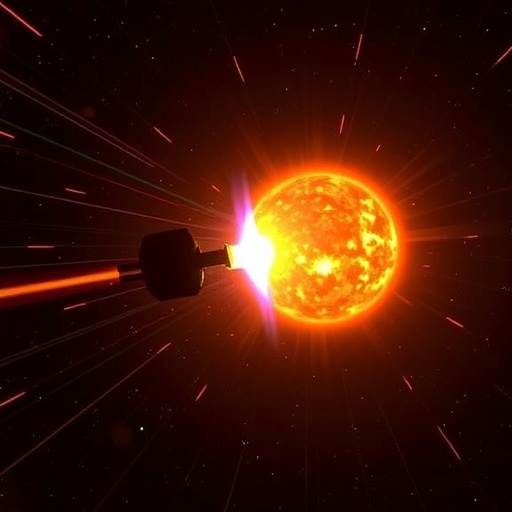
The European Space Agency’s Solar Orbiter mission has unlocked a new chapter in our understanding of the Sun’s turbulent behavior by successfully classifying the streams of energetic electrons flung into the solar system into two fundamentally distinct categories. These revelations provide critical insights into space weather phenomena, potentially reshaping how scientists forecast and mitigate the risks posed by solar activity to spacecraft and astronauts.
For decades, researchers have known that the Sun is an immense natural particle accelerator. It accelerates electrons to velocities approaching the speed of light, launching them outward in immense numbers that flood the entire solar system. These highly energized particles, termed Solar Energetic Electrons (SEEs), have long been observed, but their precise origins and the mechanics of their acceleration remained elusive—until now.
Utilizing the unprecedented capabilities of Solar Orbiter, a collaborative mission between ESA and NASA, scientists have observed over 300 separate SEE bursts between November 2020 and December 2022. This extensive dataset, gathered closer to the Sun than any previous mission could venture, has allowed researchers to map these electrons back to two distinct solar phenomena: impulsive solar flares and gradual coronal mass ejections (CMEs). Each source imprints unique signatures on the energetic electrons it emits.
Solar flares, explosive events localized to relatively small regions on the Sun’s surface, generate rapid, intense bursts of energetic electrons. These impulsive events are akin to sudden flares of light and particle radiation shooting out in quick succession. In contrast, CMEs represent massive eruptions where immense clouds of hot plasma and magnetic fields are expelled from the Sun’s atmosphere. Electrons associated with CMEs manifest more gradual releases, spreading over extended timeframes and producing a broader ‘swell’ of energetic particles traveling through the solar system.
A defining feature of this research is the ability to trace electron particles from their earliest detectable stages near the solar surface, thanks to Solar Orbiter’s suite of sophisticated instruments. This proximity provides a ‘pristine’ measurement environment, enabling precise determinations of where and when these electrons originate. No previous mission had the instrumentation or vantage point to confidently delineate these nuanced differences between impulsive and gradual SEE populations.
Another longstanding puzzle tackled by Solar Orbiter’s data concerns the apparent time delays observed between solar events and the subsequent detection of energetic electrons in space. These delays sometimes span hours, raising critical questions about the particle acceleration and propagation processes in the heliosphere. The new findings highlight that such lag arises not solely from delayed electron release at the Sun but also from the complex journey electrons undertake through the turbulent magnetic environment of the solar wind.
The solar wind—a continuous outflow of charged particles emanating from the Sun—carries the Sun’s magnetic field outward, filling the vast expanse of interplanetary space. This dynamic medium neither allows electrons to travel unimpeded nor along simple trajectories. Instead, electrons are continually scattered, deflected, and trapped by magnetic turbulence and irregularities, causing staggered arrival times and complicating detection.
These complexities underscore the significance of Solar Orbiter’s multi-instrument, multi-distance observational strategy. By measuring SEE events at varying points between the Sun and Earth, the mission effectively disentangles source characteristics from transport effects. This approach provides a more holistic understanding of how energetic particles evolve from their solar origins to their manifestations in near-Earth space and beyond.
The implications of this research are profound for space weather forecasting. Among the two categories of SEE, those associated with CMEs are particularly impactful due to their higher energy content and more extended particle emissions. CME-related particle swells have a far greater potential to damage satellites, disrupt communications, and pose radiation hazards to astronauts. Accurately distinguishing between electron populations therefore enhances predictive capabilities, enabling earlier alerts and improved risk management for space operations.
Mission scientists emphasize the collaborative nature of this breakthrough, combining expertise and instrument data from diverse European and US teams. The comprehensive catalog of SEE events, named CoSEE-Cat, has been made publicly accessible to the global scientific community. This repository offers invaluable opportunities for further multi-disciplinary analyses and will likely serve as a benchmark dataset for years to come.
Looking to the future, ESA’s planned Vigil mission promises to complement Solar Orbiter’s achievements by providing continuous, side-on observations of the Sun starting in 2031. Vigil aims to detect dangerous solar eruptions well before they rotate into Earth’s line of sight, enabling even earlier warning systems. Meanwhile, ESA’s Smile mission, launching soon, will probe how solar wind particles interact with Earth’s magnetic shield, furthering our grasp of planetary space weather dynamics.
Together, these missions form an integrated approach to constantly monitor the Sun-Earth environment, shedding light on the mechanisms driving solar storms and energetic particle events. As our reliance on space infrastructure deepens, understanding and forecasting these solar phenomena become ever more critical to safeguarding technology, communication networks, and human space exploration endeavors.
Solar Orbiter’s revelations about energetic electron sources mark a significant leap in heliophysics, illustrating the tremendous value of close-up solar observations. By disentangling the intricate threads connecting solar eruptions to particle acceleration and propagation, scientists are now better equipped to decode the Sun’s complex influence on the solar system, an influence that ultimately shapes conditions here on Earth.
Subject of Research: Not applicable
Article Title: CoSEE-Cat: a Comprehensive Solar Energetic Electron event Catalogue obtained from combined in-situ and remote-sensing observations from Solar Orbiter
News Publication Date: 1-Sep-2025
Web References: http://dx.doi.org/10.1051/0004-6361/202554830
References: Warmuth, A. et al. “CoSEE-Cat: a Comprehensive Solar Energetic Electron event Catalogue obtained from combined in-situ and remote-sensing observations from Solar Orbiter.” Astronomy & Astrophysics, 2025.
Image Credits: ESA & NASA/Solar Orbiter/STIX & EPD
Keywords
Solar Orbiter, Solar Energetic Electrons, Solar Flares, Coronal Mass Ejections, Space Weather, Particle Acceleration, Heliosphere, Solar Wind, Energetic Particles, Solar Physics, ESA, NASA
Tags: Coronal Mass Ejectionselectron burst categorizationenergetic particle originsESA NASA collaborationimpulsive solar flaressolar activity riskssolar energetic electronsSolar Orbiter missionsolar particle accelerationsolar research advancementssolar system electron mappingspace weather phenomena



